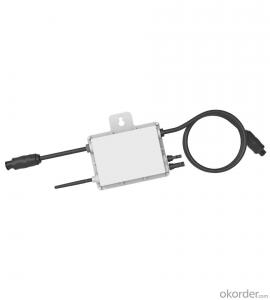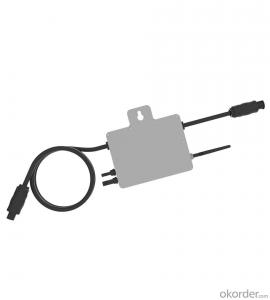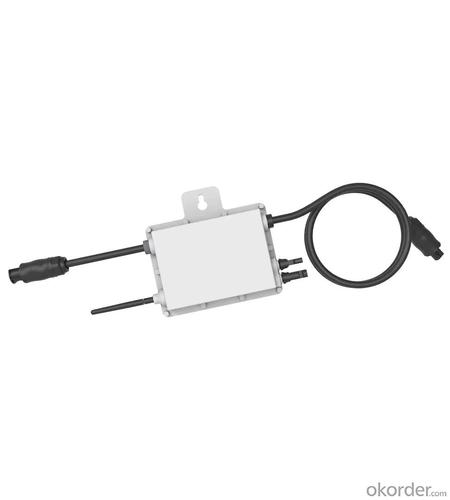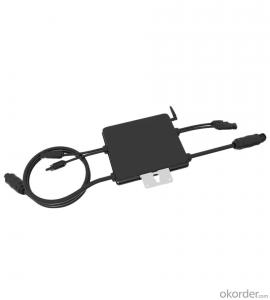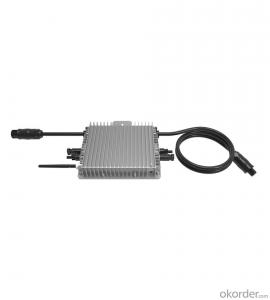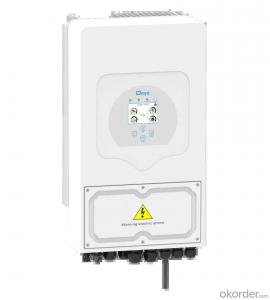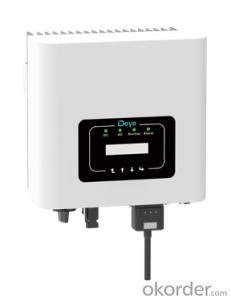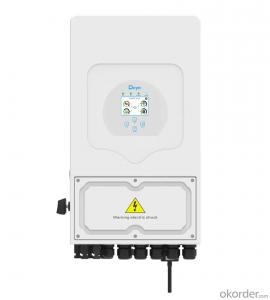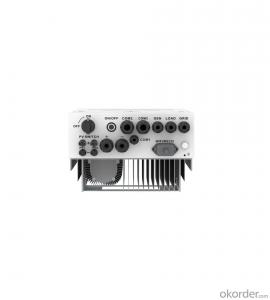All in One Solar Inverter Charger - sun300/500g3-eu-230 | 300-500w | Single Phase | 1 MPPT | Micro-Inverter | Rapid Shutdown
- Loading Port:
- Ningbo
- Payment Terms:
- TT OR LC
- Min Order Qty:
- 100 pc
- Supply Capability:
- 5000 pc/month
OKorder Service Pledge
OKorder Financial Service
You Might Also Like
Specification
| Technical Data | ||||||
| Model | SUN300G3-US-220 | SUN300G3-EU-230 | ||||
| Input Data (DC) | ||||||
| Recommended input Power (STC) | 210~400W (1 Piece) | 210~600W (1 Piece) | ||||
| Maximum input DC Voltage | 60V | |||||
| MPPT Voltage Range | 25~55V | |||||
| Full Load DC Voltage Range (V) | 24.5~55V | 40~55V | ||||
| Max. DC Short Circuit Current | 19.5A | |||||
| Max. input Current | 13A | |||||
| No.of MPP Trackers | 1 | |||||
| No.of Strings per MPP Tracker | 1 | |||||
| Output Data (AC) | ||||||
| Rated output Power | 300W | 500W | ||||
| Rated output Current | 1.4A | 1.3A | 2.3A | 2.2A | ||
| Nominal Voltage / Range (this may vary with grid standards) | 220V/0.85Un-1.1Un | 230V/0.85Un-1.1Un | 220V/0.85Un-1.1Un | 230V/0.85Un-1.1Un | ||
| Nominal Frequency / Range | 50 / 60Hz | |||||
| Extended Frequency / Range | 45~55Hz / 55~65Hz | |||||
| Power Factor | >0.99 | |||||
| Maximum units per branch | 17 | 10 | ||||
| Efficiency | ||||||
| CEC Weighted Efficiency | 95% | |||||
| Peak Inverter Efficiency | 96.5% | |||||
| Static MPPT Efficiency | 99% | |||||
| Night Time Power Consumption | 50mW | |||||
| Mechanical Data | ||||||
| Ambient Temperature Range | -40~65℃ | |||||
| Size (mm) | 189W×184H×31.5D (Without mounting bracket and cable) | |||||
| Weight (kg) | 2.15 | |||||
| Cooling | Natural cooling | |||||
| Enclosure Environmental Rating | IP67 | |||||
| Features | ||||||
| Compatibility | Compatible with 60~72 cell PV modules | |||||
| Communication | Power line / WIFI / Zigbee | |||||
| Grid Connection Standard | EN50549-1, VDE0126-1-1, VDE 4105, ABNT NBR 16149, ABNT NBR 16150, ABNT NBR 62116, RD1699, UNE 206006 IN, UNE 206007-1 IN, IEEE1547 | |||||
| Safety EMC / Standard | UL 1741, IEC62109-1/-2, IEC61000-6-1, IEC61000-6-3, IEC61000-3-2, IEC61000-3-3 | |||||
| Warranty | 10 years | |||||
Module level monitoring, safer and smarter
1 unit for 1 panel, maximize energy from each panel
Rapid shutdown function
IP67 protection degree,10 years warranty
PLC, Zigbee or WIFI communication
1 MPP trackers, module level monitoring
The SUN 300-500G3 is new generation grid-tied microinverter with single MPPT, adapting to connect 1pcs PV module. Thanks to the 1 MPP tracker design, ensuring that each PV module can harvest the highest power generation. Viewable panel performance on a PC, tablet or smart phone
- Q: What are the different types of solar inverters?
- There are three main types of solar inverters: string inverters, microinverters, and power optimizers.
- Q: Can a solar inverter be used with a remote monitoring system?
- Yes, a solar inverter can be used with a remote monitoring system. In fact, many modern solar inverters are designed to be compatible with remote monitoring systems. This allows users to monitor the performance and output of their solar system from a remote location, providing real-time data on energy production, system efficiency, and any potential issues or faults. Remote monitoring systems provide convenience, enable proactive maintenance, and help optimize the overall performance of solar installations.
- Q: Can a solar inverter be installed outdoors?
- Yes, a solar inverter can be installed outdoors. However, it is important to ensure that the inverter is designed to withstand outdoor conditions, such as rain, humidity, and temperature fluctuations. Outdoor installation should also comply with local electrical codes and regulations.
- Q: What is the maximum short-circuit current that a solar inverter can handle?
- The maximum short-circuit current that a solar inverter can handle varies depending on the specific model and design. However, most solar inverters are designed to handle short-circuit currents ranging from 500 Amps to 10,000 Amps, depending on the size and capacity of the inverter.
- Q: Can a solar inverter be used in standalone systems?
- Yes, a solar inverter can be used in standalone systems. Standalone systems, also known as off-grid systems, are not connected to the main power grid and rely on alternative energy sources such as solar power. In these systems, a solar inverter is essential as it converts the direct current (DC) generated by the solar panels into alternating current (AC) which can be used to power household appliances and other electrical loads.
- Q: What is the maximum efficiency at partial load for a solar inverter?
- The maximum efficiency at partial load for a solar inverter refers to the highest level of efficiency that can be achieved when the inverter is operating at less than its full capacity. This efficiency is typically lower than the maximum efficiency at full load, as the inverter may not be able to convert the same amount of energy with the same level of efficiency when it is not running at its maximum capacity.
- Q: Photovoltaic grid-connected inverter problem
- But Baidu Encyclopedia clearly pointed out: the zero line is the secondary side of the transformer leads the neutral point of the line, and the phase line constitutes a circuit for power supply equipment.
- Q: Can a solar inverter be repaired or does it need to be replaced?
- A solar inverter can be repaired in many cases, depending on the extent of the damage or malfunction. However, in some situations, a replacement may be necessary if the damage is severe or the inverter is outdated.
- Q: What is the role of a solar inverter in a solar-powered remote monitoring system?
- The role of a solar inverter in a solar-powered remote monitoring system is to convert the direct current (DC) electricity generated by the solar panels into alternating current (AC) electricity that can be used to power the monitoring system. It also ensures that the electricity generated matches the requirements of the monitoring equipment, regulates the voltage, and assists in efficient power transmission and distribution.
- Q: Can a solar inverter be used with a solar-powered cooling system?
- Yes, a solar inverter can be used with a solar-powered cooling system. The solar inverter converts the direct current (DC) generated by the solar panels into alternating current (AC) that can be used to power various electrical devices, including the cooling system. This allows for the efficient use of solar energy to run the cooling system, reducing reliance on grid electricity and promoting sustainability.
Send your message to us
All in One Solar Inverter Charger - sun300/500g3-eu-230 | 300-500w | Single Phase | 1 MPPT | Micro-Inverter | Rapid Shutdown
- Loading Port:
- Ningbo
- Payment Terms:
- TT OR LC
- Min Order Qty:
- 100 pc
- Supply Capability:
- 5000 pc/month
OKorder Service Pledge
OKorder Financial Service
Similar products
Hot products
Hot Searches
Related keywords
